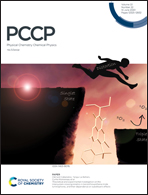Detection of electric-quadrupole transitions in water vapour near 5.4 and 2.5 μm
Abstract
Nowadays, the spectroscopic databases used for the modeling of Earth and planetary atmospheres provide only electric-dipole transitions for polyatomic molecules (H2O, CO2, N2O, CH4, O3…). Very recently, electric-quadrupole transitions have been detected in the high sensitivity cavity ring down spectrum (CRDS) of water vapour near 1.3 μm [A. Campargue et al., Phys. Rev. Res., 2020, 2, 023091, DOI: 10.1103/PhysRevResearch.2.023091]. This discovery paved the way to systematic searches of quadrupole transitions in water vapor and other polyatomic molecules. In the present work, on the basis of high accuracy ab initio predictions, H216O quadrupole lines are detected for the first time in the 5.4 μm and 2.5 μm regions where they are predicted to have their largest intensities (up to 10−26 cm per molecule). A total of twelve quadrupole lines are identified in two high sensitivity Fourier transform spectra recorded with a 1064 m path length. Ten lines in the 4030–4150 cm−1 region are assigned to the ν3 band while the lines near 1820 and 1926 cm−1 belong to the ν2 band. The derived line intensities which are largely above the dipole intensity cut-off of the standard spectroscopic databases, agree nicely with the theoretical predictions. We thus conclude that the calculated line list of quadrupole transitions, validated by the present measurements, should be incorporated in the spectroscopic databases.

- This article is part of the themed collection: 2020 PCCP HOT Articles


 Please wait while we load your content...
Please wait while we load your content...